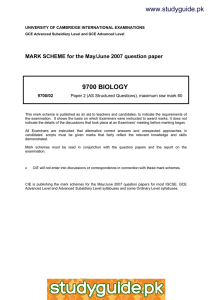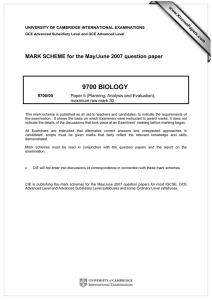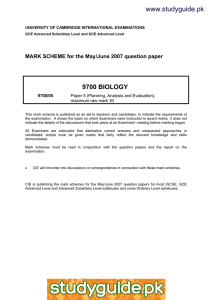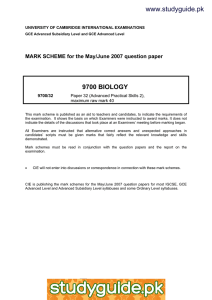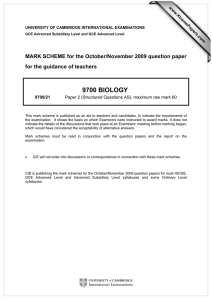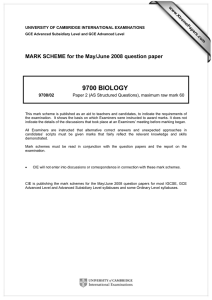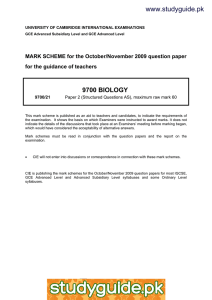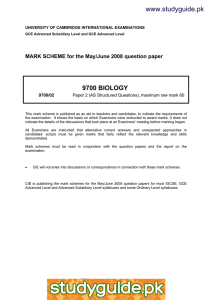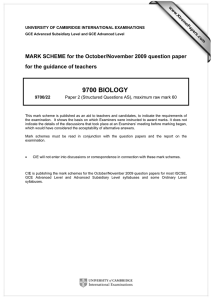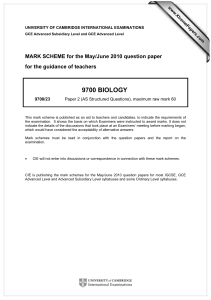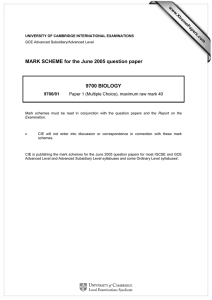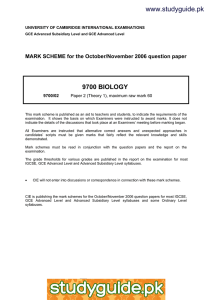9700 BIOLOGY MARK SCHEME for the May/June 2007 question paper
advertisement
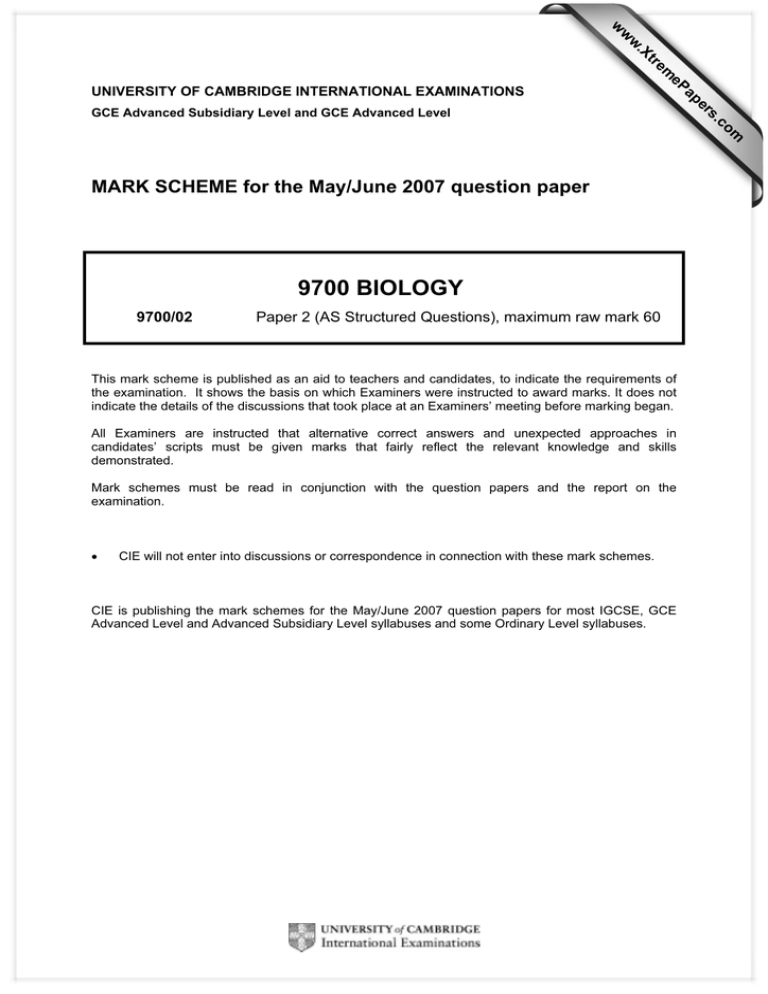
w w ap eP m e tr .X w UNIVERSITY OF CAMBRIDGE INTERNATIONAL EXAMINATIONS 9700 BIOLOGY 9700/02 Paper 2 (AS Structured Questions), maximum raw mark 60 This mark scheme is published as an aid to teachers and candidates, to indicate the requirements of the examination. It shows the basis on which Examiners were instructed to award marks. It does not indicate the details of the discussions that took place at an Examiners’ meeting before marking began. All Examiners are instructed that alternative correct answers and unexpected approaches in candidates’ scripts must be given marks that fairly reflect the relevant knowledge and skills demonstrated. Mark schemes must be read in conjunction with the question papers and the report on the examination. • CIE will not enter into discussions or correspondence in connection with these mark schemes. CIE is publishing the mark schemes for the May/June 2007 question papers for most IGCSE, GCE Advanced Level and Advanced Subsidiary Level syllabuses and some Ordinary Level syllabuses. om .c MARK SCHEME for the May/June 2007 question paper s er GCE Advanced Subsidiary Level and GCE Advanced Level Page 2 1 (a) Mark Scheme GCE A/AS LEVEL – May/June 2007 function facilitated diffusion of glucose creates a current to move mucus aerobic respiration makes ribosomes a site of transcription packages proteins into lysosomes Syllabus 9700 Paper 60 Structure B A; C; E/C ; G/E/C ; J; [5] thin, cells/walls/epithelial lining/epithelium (for alveoli) ; A 1 cell thick A 0.5µm short diffusion distance ; well supplied/better supplied, with blood/capillaries ; (alveoli provide) large surface area (when expanded) ; less/no/thinner layer of, mucus ; [max. 3] (b) alveoli – accept ora for bronchus (c) less/no/damaged, cilia ; A paralysed/not beating R killed flat cells/squames/squamous epithelium ; layers of cells ; R thicker unqualified scar tissue ; much mucus ; inflamed ; R infected A goblet cells enlarged deposits of tar (idea of) ; [max. 3] [Total: 11] © UCLES 2007 Page 3 2 Mark Scheme GCE A/AS LEVEL – May/June 2007 Syllabus 9700 (a) catalyst ; active site ; complementary (to specific substrate) ; lock and key/induced fit, correctly described ; enzyme-substrate complex ; A E-S complex lowers activation energy ; A Ea further detail of active site ; e.g. role of R groups in active site/catalytic/ binding, site/mechanism to lower Ea (b) (i) (idea of) presence of starch ; A [max. 4] [1] (ii) control ; to show, enzyme involved/enzyme catalysed reaction/not spontaneous/AW ; enzyme denatured by boiling ; (c) A Paper 60 [max. 2] starch, broken down/converted to glucose (1-) phosphate/AW ; ora for B at pH 6.5/nearly neutral/AW, enzyme is active idea/AW ; e.g. ref to optimum at or near 6.5 (B) at pH 2.0/acidic qualified, enzyme is inactive idea/AW ; e.g. well away from optimum further detail e.g. specific effects of pH / bonds affected by hydrogen ions; C enzyme denatured, by boiling/high temperature ; ref to bonds broken by high temperature ; (D) glucose phosphate gives, no reaction with iodine/negative result ; A no starch/no substrate added gives, no reaction with iodine/negative result [max. 4] (brackets) denote the letter not required for mark [Total: 11] © UCLES 2007 Page 4 3 Mark Scheme GCE A/AS LEVEL – May/June 2007 Syllabus 9700 (a) (i) 6 ; Paper 60 [1] (ii) centromere ; site of attachment to, microtubules/spindle fibres ; A holds chromatids together R ref to centromeres dividing (iii) any pair shaded in ; A more than one pair [2] [1] (iv) either or two daughter chromosomes shown ; centromeres leading as shown above ; (b) chromosome, unravels/becomes chromatin/AW (during telophase) ; transcription ; described/mRNA produced ; replication/new DNA produced ; semi-conservative/description e.g. unzips and bases pair up ; ref to histone proteins ; [2] [max. 3] (c) halved/6 -> 3 ; A diploid -> haploid/2n -> n to restore diploid number at fertilization/ to avoid chromosome number doubling in every generation ; [2] [Total: 11] © UCLES 2007 Page 5 4 Mark Scheme GCE A/AS LEVEL – May/June 2007 Syllabus 9700 Paper 60 (a) (i) source = leaf/mesophyll/palisade/spongy qualified sink = flower/fruit/seed/stem/bud/root/tuber/storage organ/young leaf/meristem/pollen/nectary/AW ; [1] (ii) C sieve, (tube) element/cell, D companion/transfer, cell ; [1] (b) source to cell C correct ref (sucrose) loaded ; H+ pumped out, sucrose moves in through co-transporter ; role of companion cells in moving sucrose into sieve tube element ; sucrose diffuses down concentration gradient (anywhere) ; ref to plasmodesmata ; [max. 2] cell C to sink water enters by osmosis/water moves down its Ψ gradient ; hydrostatic pressure builds up ; (idea that sucrose) unloaded/used at sink ; water follows by osmosis ; idea there is a difference in pressure/pressure gradient (between source and sink) ; mass flow ; [max. 2] (c) small surface area : volume ratio ora ; accept described idea of distances too great for diffusion/diffusion rate too slow ; idea of cells requiring, substances/named substances, are at a distance from site production/ absorption ; idea of mass or bulk transport/described ; [max. 2] [Total: 8] © UCLES 2007 Page 6 5 (a) A B Mark Scheme GCE A/AS LEVEL – May/June 2007 Syllabus 9700 Paper 60 passive artificial ; active artificial ; if artificial omitted score one mark if passive and active are correct [2] (b) mark (i) and (ii) together (i) antibody, destroyed/broken down ; antibody excreted ; (ii) no antigen entered body ; no immune response ; no, (active) B cells/plasma cells/memory cells ; no antibody made ; AVP ; e.g. further detail of lack of immune response / no stimulation of B cells by T helper cells/no cloning [max. 3] (c) line drawn on graph to show increase occurs faster than in primary response ; higher peak of concentration than in primary response ; (d) antibody is specific (for tetanus) ; further detail ; e.g. variable region always some (circulating) antibody molecules, linked with qual ;; [2] [max. 2] [Total: 9] © UCLES 2007 Page 7 6 Mark Scheme GCE A/AS LEVEL – May/June 2007 Syllabus 9700 (a) 7.0 nm ; (b) K Paper 60 [1] permits movement of, ions/(small) water soluble molecules/ charged/polar/hydrophilic/any e.g. ; facilitated diffusion/active transport ; [max. 1] L cell recognition/(surface) antigen/receptor/cell adhesion/cell marker/ binding site ; forms hydrogen bonds with water to stabilize membrane structure ; [max. 1] M barrier to, water soluble compounds/ions ; allows passage of lipid soluble substances / named e.g. ; ref hydrophobic interactions with integral proteins ; ref structure of fatty acid tails maintains fluidity ; N [max. 1] regulates, fluidity/stability ; storage ; restricts movement of phospholipids ; influences permeability of membrane ; [max. 1] [4] (c) idea of large molecule ; polar ; water soluble/not lipid soluble ; A hydrophilic A not able to pass through phospholipid bilayer / AW [max. 2] (d) facilitated diffusion because the rate of uptake increases with increasing glucose concentration, up to a plateau/constant rate ; A figs to explain because no more proteins available/all proteins in use ; if passive diffusion rate would continue to rise ; cannot be active transport as rate would be independent of concentration (except at low concentration) ; [max. 2] (e) (active transport) uses, energy/ATP, to move (substance) against a concentration gradient ; ora [1] [Total: 10] [Total mark for paper = 60] © UCLES 2007
